Knowing which trees are growing in woodlands, forests, or parks can be aided by recognizing tree leaves. The form, edging, size, and patterns of leaves may all be used to identify them. Tree leaves with heart, ovoid, rounded, lanceolate, and triangle forms are seen on some deciduous trees. The leaves of evergreen coniferous trees are needle-like or scale-like clusters.
You’ll learn about leaf identification and identifying the many components and architectures of tree leaves in this article. Other plants, such as flowers, shrubs, and bushes, have leaf forms similar to those described in this identification guide.
Tree Leaf Identification
Identifying tree leaves isn’t just a matter of their appearance. Rounded, elongated, or tapered to a point are the three types of ovate-shaped tree leaves. These leaves may also be smooth, serrated, notched, or lobed on the margins. The venation patterns on the leaf, as well as its color and size, can be used to identify a tree by its leaves. Examining how the leaves are positioned on the stem is another method of determining tree species. Some leaves grow opposite each other and others are arranged in an alternate pattern in some photographs of leaves and stems.
There are many ways to recognize tree species by their leaves. Learning how to recognize many trees and plants is easier if you understand the principles of how leaves are identified (called leaf morphology).
Types of Tree Leaves with Pictures for Easy Identification
Let’s look at how leaves grow on stems before we look at how to tell different species of trees apart by their shape. Phyllotaxis is a botanical term that refers to the way leaves develop on stems.
Opposite Leaves
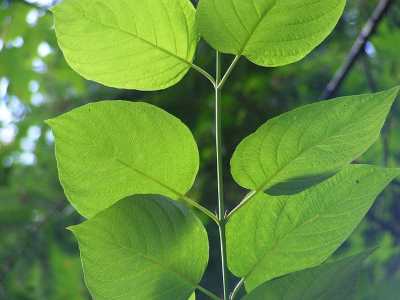
Opposite leaves grow on either side of the stem, growing immediately opposite each other. The leaves on either side of the stem are in pairs, as can be seen in photographs of alternate leaves. The point on the stem where stems, buds, or leaves grow from is known as the plant node.
Opposite leaves grow on the same plant node. The leaf form varies depending on the species of tree, and several kinds of trees have stems with opposing leaves. Simple or compound leaves may be found growing opposite each other. Maples, ash trees, elders, olive trees, and eucalyptus are all examples of trees with opposite leaves.
Alternate Leaves

Alternately expanding leaves on stems create a staggered pattern, with each leaf appearing to grow in between those on the other side. As a result, each plant node has just one leaf. Oak trees, sycamore, mulberry, birch, hickory, and willow are all examples of trees with alternating leaves.
Whorled Leaves

Whorled leaves are the third kind of leaf arrangement seen on certain trees, and they spread out from a single point. In the same manner as opposite leaves, whorled leaves develop. On stems with whorled leaves, however, instead of having just two leaves arranged in an opposing arrangement, there are three or more. Whorled leaves are rare on trees and shrubs.
Simple Leaves

The leaf blade on simple leaves is solitary. Simple or complex leaves may be used to differentiate tree types in photographs. The number of leaves that develop on the petiole is referred to by these phrases. The stem and the leaf blade (lamina) are connected by a thin, slender stalk called the petiole.
Simple leaves with just one blade growing on the stalk make up foliage on trees and plants. As a result, one blade per petiole is found on a simple leaf. On the stem, simple leaves may develop in various directions or in direct opposition to one another. Maple trees, sycamore trees, elm trees, and oak trees are some examples of deciduous wood with simple leaves.
Compound Leaves
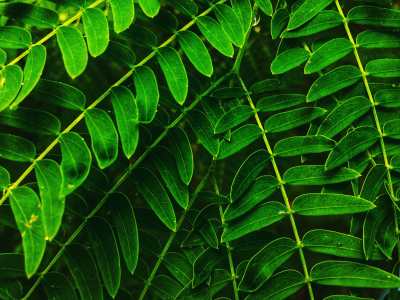
Compound leaves are when a number of leaflets grow on one petiole and are joined to a single stem. This is like a collection of little leaves that join to make one big leaf in your head. Figuring out if a leaf in your hand is a simple or compound leaf can be difficult. A node where the leaf/leaflet joins the stem is one way to tell them apart.
A simple leaf is created if there is a node, whereas a complex leaf is created if there isn’t. Ash trees, walnut trees, hickory trees, and horse chestnut trees are all examples of trees with compound leaves. Compound leaves come in a variety of shapes and sizes, and understanding what they are can assist with tree identification.

Leaves that are made up of various compounds. Pinnate leaves, palmate leaves, and double pinnate leaves are displayed from left to right.
Pinnate leaves (compound)
The leaflets of the compound leaf grow in a feather-like pattern along the length of the petiole, which is known as pinnate leaves. Pinnately compound leaves are the name given to these types of leaves. Walnut, ash, pecan, and hickory trees all have pinnate leaves that can be found on them.
Palmate leaves (compound leaves)
Palmate leaves have a leaf stalk that ends in a cluster of leaflets. These complex leaves, with a palm and fingers, often resemble a hand. Palmate leaves are the result of this. Horse chestnut and buckeye trees are examples of palmate-leafed trees.
Double pinnate (bipinnate) leaves
Leaves of bipinnate trees look like fern leaves and are bipinnate in form. The compound leaves in photographs of double pinnate leaves have a number of secondary stems with leaflets growing in an opposing pattern, as you can see. Honey locust trees, Texas redbud trees, and Kentucky Coffee trees are some examples of trees with bipinnate leaves.
Lobed, Toothed, or Entire Leaves
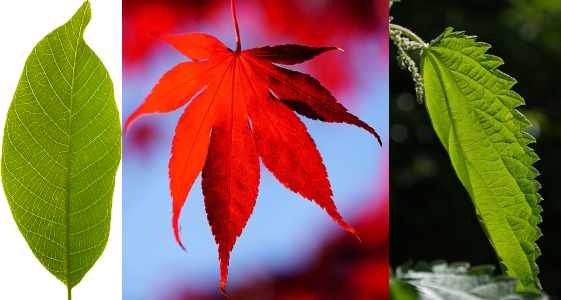
The leaf form of a tree may be used to identify it. The overall form of the leaf around its margins is extremely essential in distinguishing types of tree leaves from left to right: unlobed, lobed, and serrated. Leaves’ margins create patterns that aid in the identification of trees and are typically unique to each species.
Entire leaves (unlobed)
The term “entire leaves” refers to the fact that most oval or circular-shaped leaves have a smooth, circular edge with no additional characteristics. You’ll learn more about complete leaf shapes later in the article. Unlobed leaves are another name for these leaves.
Lobed leaves

The white oak leaf (left) and the maple leaf (right) are examples of lobed leaves with rounded or pointed ends. These earlobe-like structures make up these leaf blades, but they create a single leaf. Depending on the species of tree, the clefts or depressions between the lobes might be deep or shallow.
A sinus is the space or depression that separates two lobes. Oak trees and maple trees are two examples of lobed-leaf trees. The distinctions between the kinds of lobes present in these leaves may be seen in photos. White oak tree leaves have a rounded lobe shape, whereas maple trees have pointed lobes.
Toothed leaves
Toothed leaves are those with serrated edges or tooth-like designs around the margins. The serrated margins of trees vary depending on the species, and you may need to examine carefully to perceive them. A steak knife might resemble other forms of toothed leaves. Chestnuts, elms, hazel trees, rowan, and ash trees are all examples of plants with softer edges and round ‘teeth.
Evergreen Coniferous Tree Leaves
Coniferous evergreen trees, such as pine, spruce, cedars, and fir trees, have leaves despite not looking like they do. Needle-like leaves, both hard and soft, make up most of the foliage of evergreen coniferous trees. The many forms of coniferous leaves will be looked at in further depth.
Single Needles

The rows of needles are attached directly to the twig in aromatic leaves found on many trees in the conifer class Pinopsida. Fir trees, spruces, and cypress trees are examples of conifers with single needles.
Cluster and Bundle Needles

Cluster or bundle needles are another kind of evergreen conifer leaf that Pine trees have. These develop along the tree’s branches like a cluster of evergreen needles. Pines have cluster needles, which you may use to differentiate them from fir trees.
Leaf Shape, Margin, and Venation
By examining the way leaves are arranged on the stem and their overall form, we’ve examined ways of distinguishing them. Understanding the form of specific leaves may help you verify the tree species quicker by looking at its variety of leaves.
Tree leaf shapes – identification chart
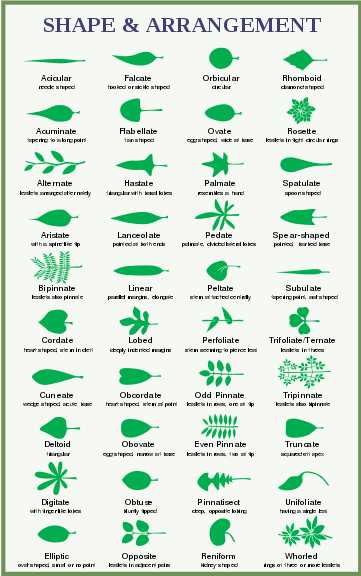
Leaf shape and arrangement are represented in a tree leaf chart. The most common way people attempt to identify the species of tree is by looking at the form of the leaf. The shape of the leaf, as well as its edges, are frequently used to identify what kind of tree it came from. The following are some of the most frequent leaf forms:
- Ovate The widest point of the leaves is near the stalk, and they are egg-shaped.
- Obovate The tapered end of a tear-shaped leaf is at the stalk, as described by
- Lanceolate The tip of a lance-shaped leaf, as if from a lance.
- Acute The tip of the leaf is pointed and its edges are stretched and slightly oval.
- Rhomboid Triangular leaves with tooth edgings are available.
- Spatulate The leaves are shaped like a spatula, as the name implies.
It’s also a good idea to remember that the leaf arrangement isn’t determined by the leaf shape, in addition to the shapes mentioned above. On stems, for example, compound or alternating leaves develop ovate and lanceolate leaves.
Tree leaf margins or edges – identification chart

Leaf margins have a variety of edging types. The margins of many types of leaves play a significant role in defining their overall shape and pattern. When it comes to identifying trees with lobed leaves, this is especially true. The type of edging present on leaf margins, such as lobed, smooth, or serrated edges. Some of the following words have been used to describe leaf borders:
- Crenate Around the margins of the leaves, there are rounded teeth.
- Dentate The edges of leaves have teeth-like characteristics, but they are not round; they are sharp.
- Serrated The teeth on a circular saw are what the leaves resemble.
- Undulate A wavy pattern can be seen around the margins of the leaves.
The depth of the spaces between the lobes also has an impact on the leaf’s overall shape. Pinnate leaves may appear to be some lobed leaves. Lobed leaves with shallow lobes, on the other hand, have a more undulated appearance.
Tree leaf venation – identification chart
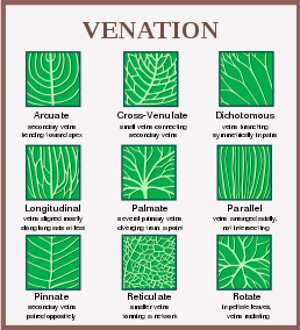
Vein structure in leaves is shown on a tree leaf chart. Another important fact in identifying the type of leaf is to know the structure of the veins in tree leaves. Nutrient delivery to all areas of the leaf is key to leaf veins. Photosynthesis relies heavily on the veins in each leaf. The midvein or midrib runs through the center of all types of leaves.
The leaf structure is formed by small veins or capillaries branching out from the midvein to create complicated patterns. The following are some of the venation patterns seen in tree leaves:
- Pinnate The central vein that runs the length of the leaf divides into two veins, which branch out in opposing directions.
- Palmate The shape of a leafless tress is formed by capillaries branching out from the midvein.
- Rotate Veins appear to branch out from a center point and resemble spokes on a wheel.
- Dichotomous At the margin of the leaf, veins branch out in pairs.
